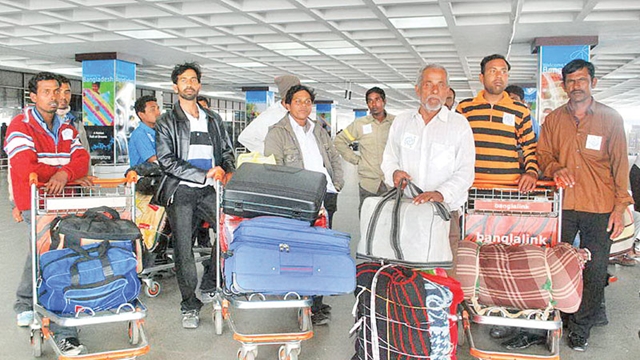Rubel Rana
Published:2018-05-27 16:33:58 BdST
Worrying development in manpower export
FT ONLINE
The negative development, as reported last Friday in this paper, on the country's manpower export front during the first four months of the current calendar year would only revive the worries of the recent past. The manpower export during the period declined more than 26 per cent compared to that of the corresponding period of 2017.
The major cause behind this unsavoury development is, as usual, the decline in outflow of Bangladeshi workers to the Gulf countries, mainly to the Kingdom of Saudi Arabia (KSA). The drop of Saudi recruitment during the period under review was more than 50 per cent.
Such a large decline in recruitment to a country, which traditionally has been the top-most destination of Bangladeshi workers, is truly an ominous development. The Saudi authorities, much to the disappointment of the Bangladeshi job-seekers, recently stopped recruitment of foreign workers in 12 categories of jobs. Unfortunately, these are the categories where Bangladeshi workers are employed in large numbers.
The KSA has, however, kept its door wide open for women workers. But, after an initial rise, not many Bangladeshi women workers are interested to take up employment in that country or any other Gulf country. The alleged ill-treatment by the employers of the recruiting countries is blamed for their dwindling interest.
The large drop in recruitment of Bangladeshi workers, after a notable improvement noticed in the outflow of manpower since 2015, should stir up worries among the country's policymakers for a number of reasons. If the current trend persists, its negative impact would soon be felt on the country's balance of payments (BoP).
Already, its BoP has come under pressure, mainly due to a widening deficit in the current account. The remittance inflow during the last few months has been on track. But this situation is most likely to change in the coming months because of slowdown of the overseas manpower recruitment.
In such a situation, the government cannot continue watching such a development from a distance. It has to devise strategies to find out alternative markets and reverse the situation in the Gulf countries. It may reach out to the top authorities of the KSA and try to convince them to beef up recruitment of Bangladeshi workers. One can pin hope on the success of such a strategy, for the diplomatic engagement between Bangladesh and the KSA has of late been very strong.
Finding out alternative job markets could be yet another very practical solution. However, given the country's quality of manpower, in terms of skill level, it would not be an easy job. Yet there is a silver lining on the horizon. Malaysia, an important destination of migrant workers, after the Gulf countries, has increased recruitment of Bangladesh workers in recent months. Efforts need to be there to ensure a positive approach from the new Malaysian government, headed by Dr. Mahathir Mohammed, who knows Bangladesh very closely.
Another issue---gathering correct information about the net annual outflow of jobseekers--- deserves a serious attention of the country's policymakers. The Bureau of Manpower Employment and Training (BMET) keeps track on the number of outbound workers, but its information about the returnee workers is highly unreliable. So, there should be a system in place so that a data on net annual outflow of workers is available for planning purposes at the national level.
Unauthorized use or reproduction of The Finance Today content for commercial purposes is strictly prohibited.


